Slack User Guide
Using the Slack integration after installation
After completing the connecting PagerDuty with Slack, responders can handle the full incident lifecycle directly in Slack using slash commands or interactive buttons. Key features include dedicated incident channels, multi-channel notifications, and essential actions like acknowledgment and escalation—all without switching to the PagerDuty web interface. Teams using PagerDuty Advance can use the AI assistant for automated status updates and incident insights.
- Link User Accounts
- Create and Link Incident Slack Channels
- Available Actions
- Create Incidents as an Unlinked Slack User
- Create an Incident Trigger Slack Workflow
- Add a Slack Contact Method
Link User Accounts
Users must link their PagerDuty and Slack user accounts to perform PagerDuty actions in Slack or create new channel connections in the PagerDuty. Each user can link their accounts after the initial integration is complete.
To link your PagerDuty and Slack accounts:
- In a public Slack channel, run the command
/pd oncall. - Click link your accounts. You will be directed to a browser window and presented with a prompt to sign in to PagerDuty.
- Complete the PagerDuty login flow. Read Log In to PagerDuty for more information.
After successfully signing in to PagerDuty, your Slack and PagerDuty users will be linked.
Create and Link Incident Slack Channels
The Slack integration offers two channel types:
- Dedicated Channel: Provides a single workspace for active incident response with full command access and responder collaboration. This is where the work happens.
- Notification Channel: Focuses on broadcasting updates to keep stakeholders informed across teams. Notification channels ensure the right people stay in the loop.
Dedicated Channel
Dedicated incident channels provide a centralized space for incident response and collaboration. These channels provide access to dedicated channel commands and automated workflows, streamlining your team's response process.
Dedicated Incident Channel
Each incident can have one dedicated channel where responders can coordinate actions, share updates, and track resolution progress.
Create an Incident Dedicated Channel
You can automate channel creation using Incident workflows, or you can manually create channels, as needed.
Create an Incident Dedicated Channel Automatically
Automatically create a dedicated channel for your incidents by configuring an Incident Workflow that uses the Create Incident Dedicated Channel workflow action. Please read Incident Workflows for more information.
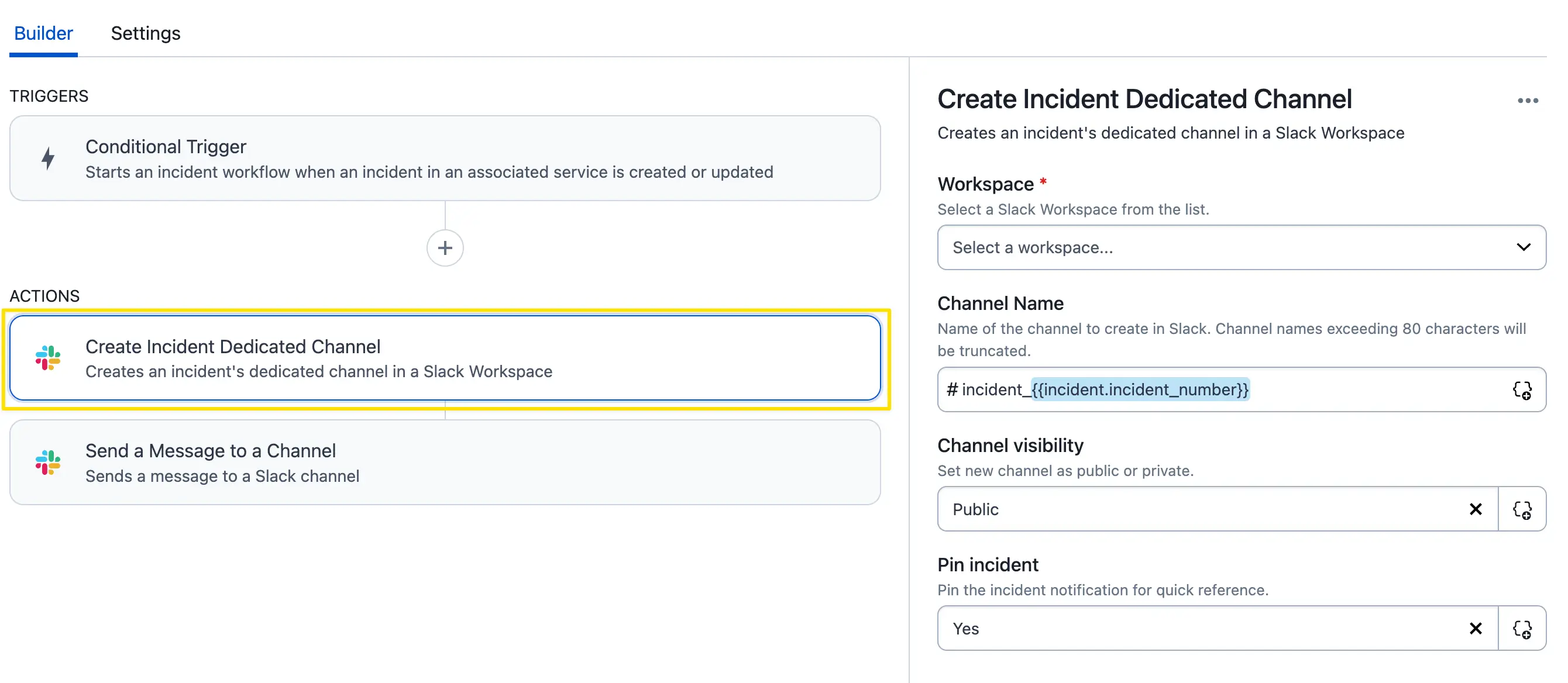
A workflow using the Create Incident Dedicated Channel action
Create an Incident Dedicated Channel Manually
In the PagerDuty Web App:
On an active incident, click into the details page and then click Set Channel to the right of Dedicated Channel.
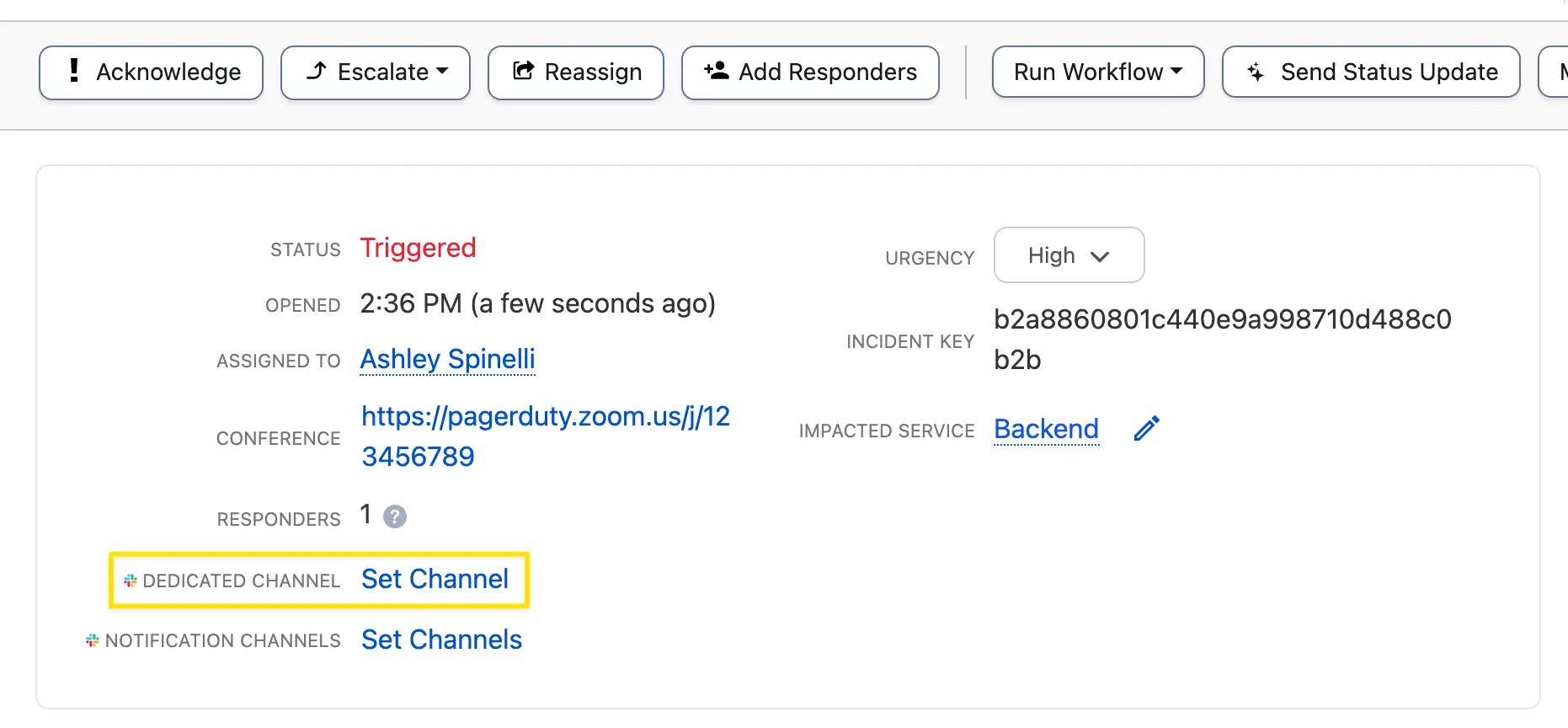
Create a Dedicated Channel from the PagerDuty web app
In Slack:
On an existing incident card incident in Slack, click Create Dedicated Channel. Note: This option may instead list under the More actions menu, depending on your configuration.
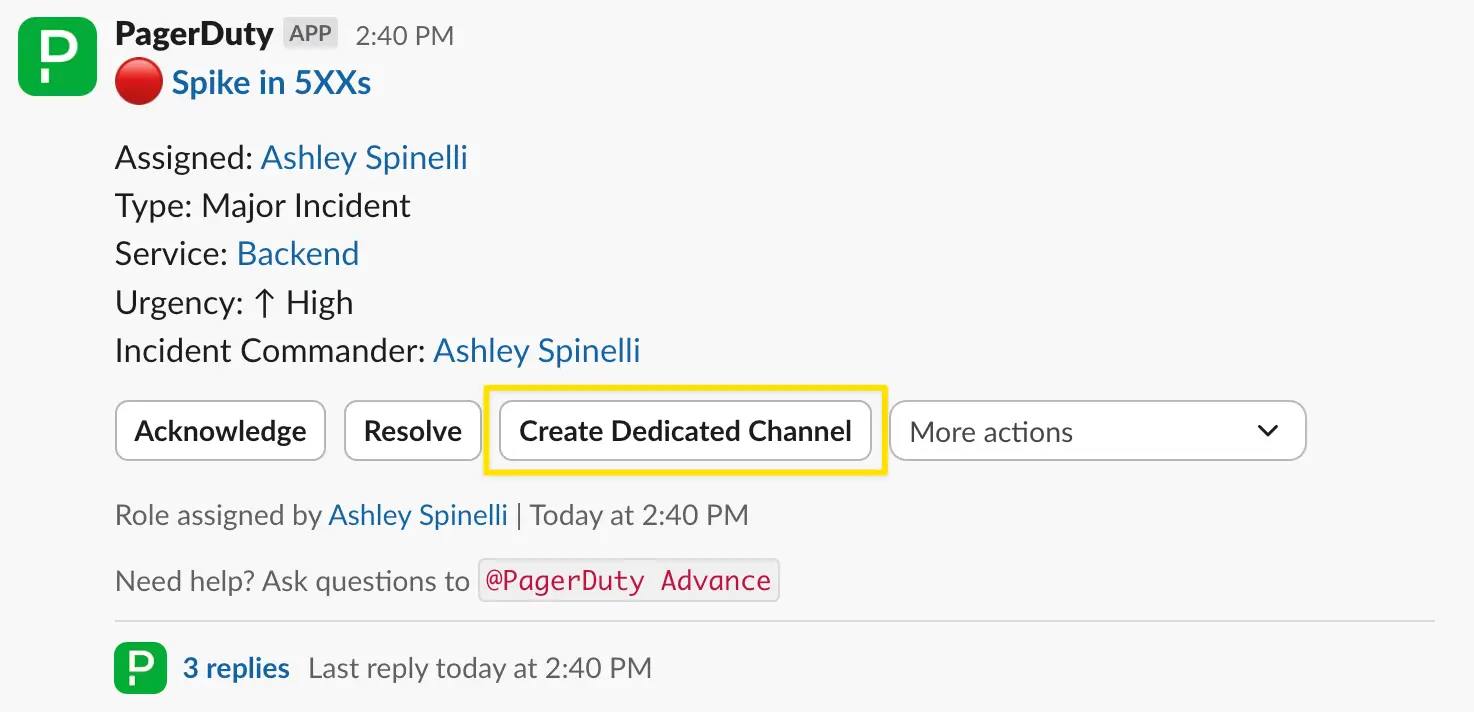
Create a Dedicated Channel from the PagerDuty incident card in Slack
Notification Channel
Notification channels help you bring awareness of an incident to multiple channels in Slack. You can link these notification channels when an incident opens, or as the incident progresses and you need to inform additional groups.
When you link a notification channel to an incident, PagerDuty sends an incident card to the notification channel. This card continuously updates as the incident progresses to reflect the current state of the incident.
If the incident also has a dedicated incident channel, users can click Join Dedicated Channel to join the response.
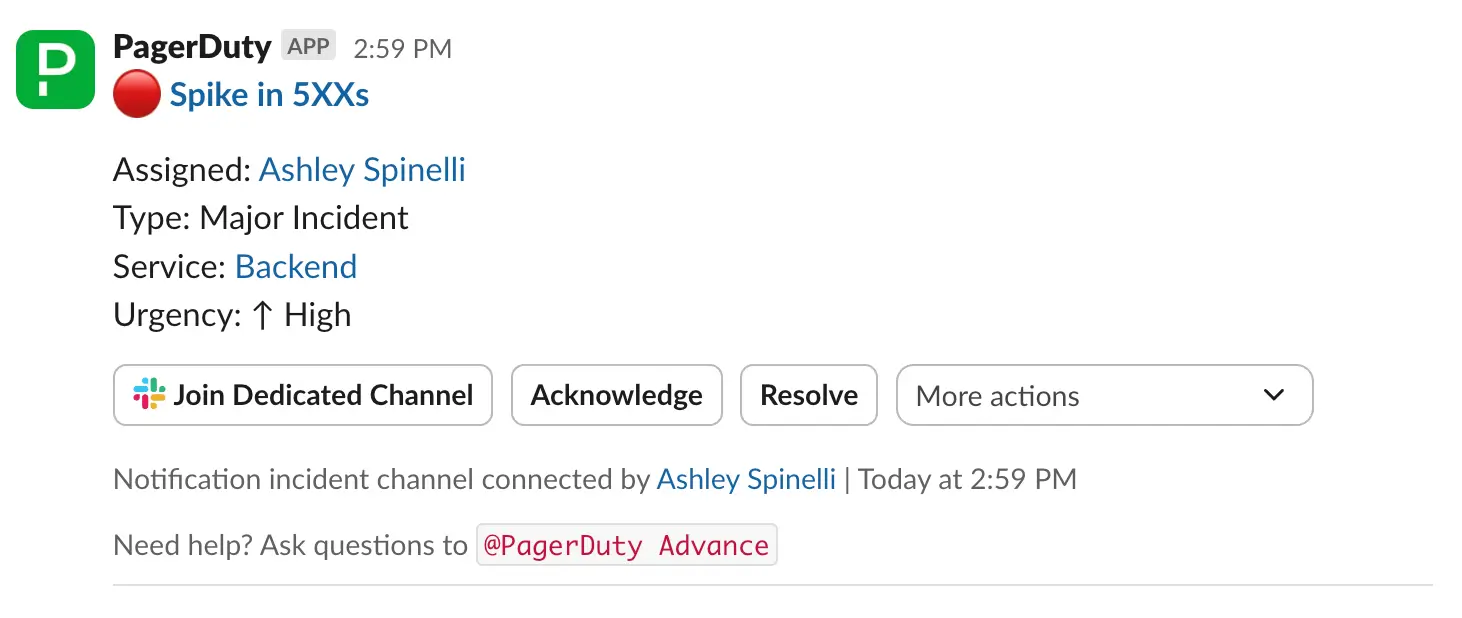
A PagerDuty incident card in a notification channel
Notification Channels
An incident may have up to three linked notification channels.
Link an Incident Notification Channel
You can automatically link notification channels with incident workflows, or you can manually link channels, as needed.
Link a Notification Channel Automatically
Automatically link notification channels to your incident by configuring an Incident Workflow, or multiple, that use the Create Incident Dedicated Channel workflow action. Please read Incident Workflows for more information.

A workflow using the Link Incident Notification Channel action
Link a Notification Channel Manually
In the PagerDuty Web App:
User Permissions
- When you click Set Channels you may receive a prompt to authorize the connection between your PagerDuty and Slack accounts.
- When linking notification channels, you will only be able to view channels that you have permission to access in Slack.
- If your PagerDuty account is connected to multiple Slack workspaces, you will have the option to select which workspace to use.
On an active incident, click into the details page and then click Set Channels to the right of Notification Channels.
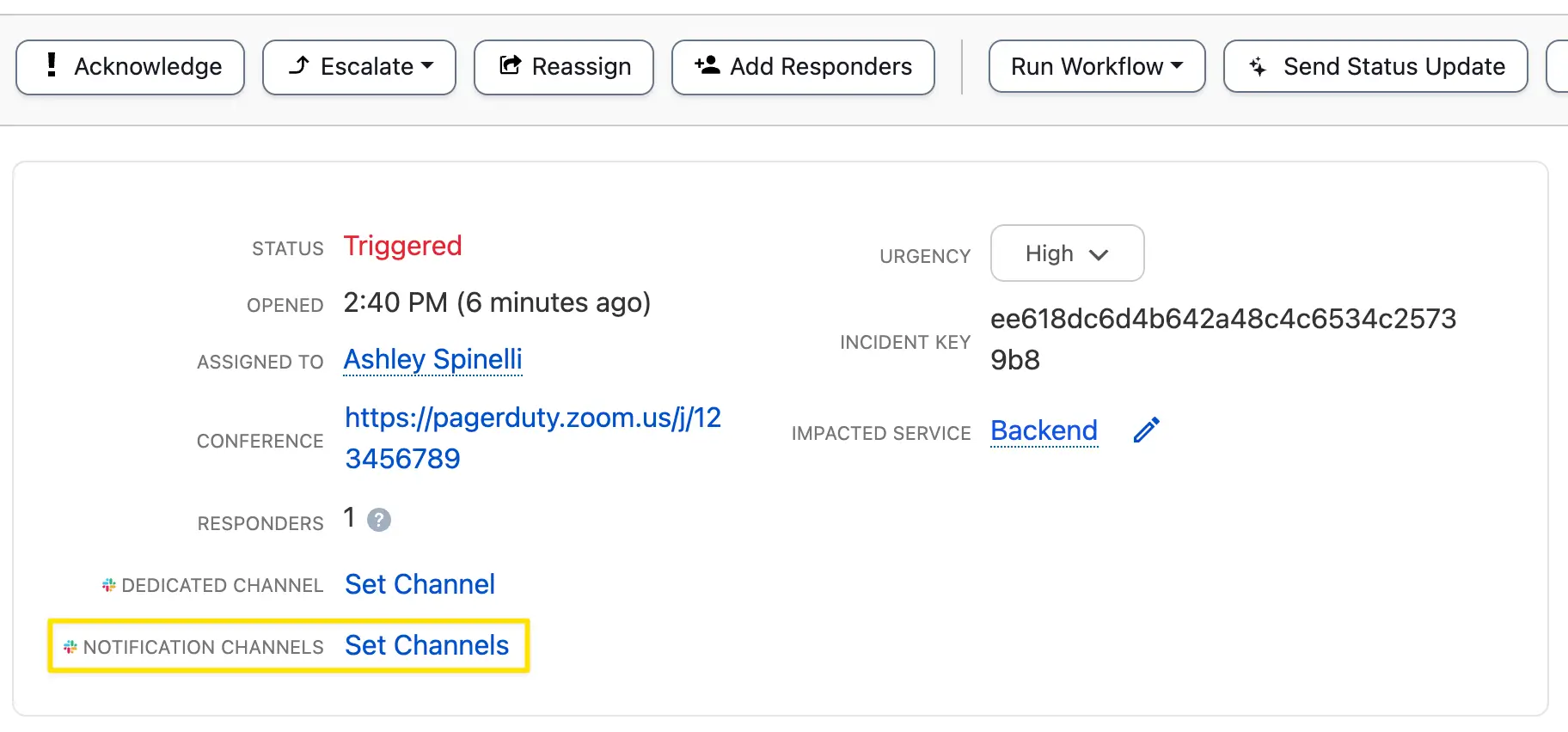
Link a Notification Channel in the PagerDuty web application
Available Actions
Slash Commands
PagerDuty EU Service Region
If your PagerDuty account is in the EU service region, you'll need to use
/pdeuto run all slash commands instead of/pd.
Help Command
Run /pd or /pd help in Slack to return a message with suggested actions, and a directory of all available incident actions. This help response is interactive, and you may click the provided buttons to take the listed action.

PagerDuty help response, outside of an dedicated incident channel
The help command differs if you are running it inside or outside of a dedicated incident channel to provide an accurate listing of commands relevant for your current situation. Below is an example help response from a dedicated incident channel:

PagerDuty help response, within a dedicated incident channel
General Commands
You can run general commands with parent messages in any Slack channel or conversation, with the exception of the PagerDuty app's chat channel. These commands can be used to view help information, trigger an incident or manage PagerDuty configuration.
| Command | Description |
|---|---|
/pd or /pd help | Display a help message. |
/pd trigger or /pd open | Trigger an incident. |
/pd oncall | View who is on call for a service. |
/pd insights | Configure the PagerDuty Analytics Slack Integration to send recurring insights to Slack. |
/pd unlink | Unlink your current Slack user from your PagerDuty user. |
/pd invite @[Slack User] | Invites the specified Slack user to your PagerDuty account. |
/pd connect | Connect a service or Team to the current Slack channel. |
/pd amazonq [question] | Use PagerDuty Advance to retrieve information from data sources in Amazon Q. |
/pd scribe | Add a Scribe Agent to your incident’s meeting, to send meeting transcripts to the current Slack channel. |
Dedicated Channel Commands
You can run dedicated channel commands with parent messages in an Incident Dedicated Channel. These commands enable taking efficient actions on the incident. For example, you can type /pd ack in the Slack message box to quickly acknowledge the incident.
Additionally, you can invoke many actions in a one-step, or two-step process. For example, to add a note to an incident, you can type /pd note, which will open a modal to type your note. Alternatively, you can type /pd note This is my note to immediately add a note with the contents This is my note to the current incident.
A full directory of actions and commands is listed below:
| Command(s) | Description |
|---|---|
/pd ack or /pd acknowledge | Acknowledge |
/pd resolve or /pd close | Resolve |
/pd note or /pd note {your note} | Add a Note |
/pd status or /pd status {text of your status update} | New Status Update |
/pd priority or /pd severity | Change Priority |
/pd worklow or /pd iw or /pd iw {exact name of your workflow} | Run a Workflow |
/pd reassign | Reassign |
/pd responder | Add Responder |
/pd escalate | Escalate |
/pd roles | Assign Roles |
/pd task or /pd task {name of your task} | Create a Task |
/pd tasks | View All Tasks |
/pd type | Change Incident Type |
/pd {custom field name} | View/Edit Custom Field |
Incident Card Actions
When using a dedicated channel, notification channels or service/team channel connections, PagerDuty will send an incident card to the channel. These incident cards display buttons, allowing responders to take action similar to slash commands in a dedicated channel. Incident cards display the following actions:
- Acknowledge: Acknowledge the incident.
- Resolve: Resolve the incident.
- Join Dedicated Channel: If a dedicated channel exists for the incident, a button displays to join the dedicated channel.
- Run a Workflow: Run an Incident Workflow.
- More actions…: Select the dropdown to access the below actions. Note: Not all actions are available on all pricing plans. Please contact Sales to upgrade to a pricing plan that offers any features not present in your account.
- Add a Note : Add a note to the incident.
- Add Responder: Add a responder to the incident.
- View Details: View incident details within the PagerDuty web app.
- Add Task: Create and assign an Incident Task.
- View Tasks: View existing Incident Tasks for this incident.
- Assign Roles: Assign Incident Roles to responders.
- Change Priority : Change an incident’s priority.
- Reassign: Reassign the incident to another user, escalation policy, escalation level or service.
- Escalate: Escalate the incident to the next on-call responder.
- Create Channel: Create a dedicated Slack channel for the current incident.
- New Status Update: Create a new status update for the incident.
- Change Type: Change the incident type.
- Run an Action: Run an Automation Action.
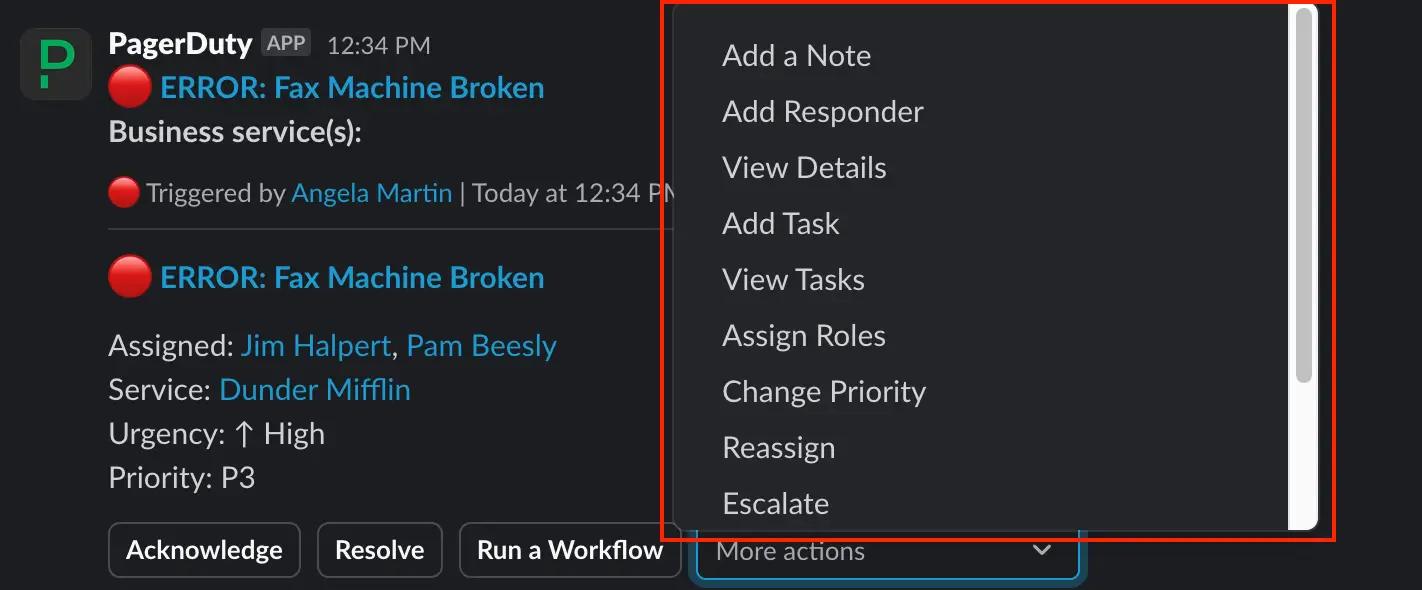
Incident actions in Slack
View Impacted Applications in Slack
View customer service application impact during an incident in Slack. Services with Salesforce or Zendesk integrations will list the number of cases related to the current incident, with links to individual cases.
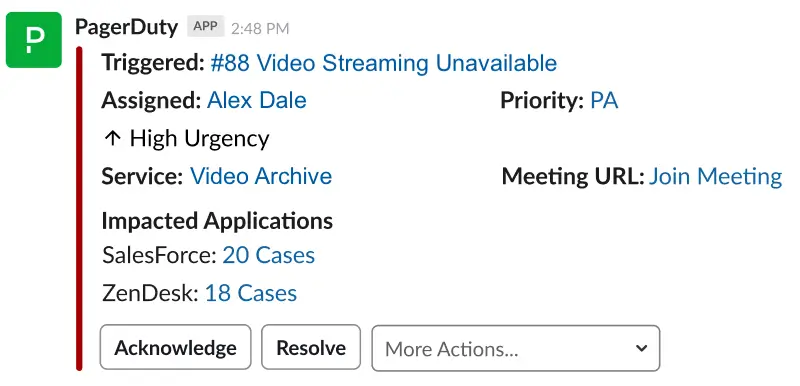
PagerDuty incident card in Slack
To view individual cases:
- To the right of the application you would like to view, click
[#]Cases. - You will see a list of related cases in the modal that appears. Click a case number to navigate to the integrated application and view the case.
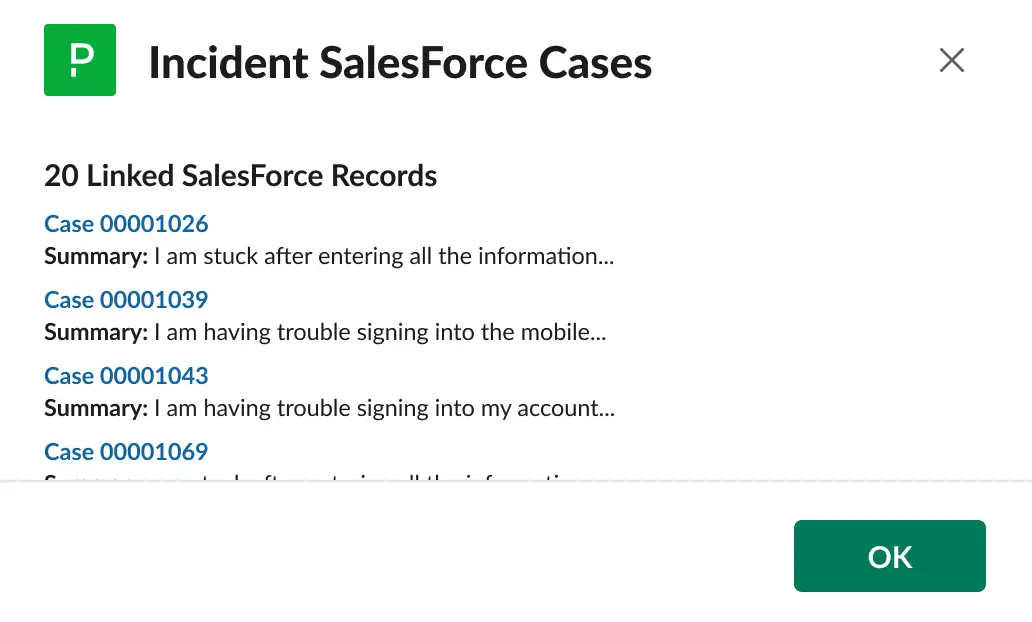
Linked SalesForce cases
PagerDuty Advance
Accounts with PagerDuty Advance can chat with the interactive assistant, generate status update drafts, and more by mentioning @PagerDuty in an incident channel. Please read PagerDuty Advance for more information.
Administrators should read Manage PagerDuty Advance Account Settings for more information about managing which actions and information PagerDuty Advance can access.
Jeli
If your account has Jeli, the integration will automatically create a Jeli Post-Incident Review when the incident resolves. Please read Jeli Post-Incident Reviews for more information.
Create Incidents as an Unlinked Slack User
If your PagerDuty administrator has enabled incident creation for unlinked users, you can create incidents via Slack command, even without a linked PagerDuty account:
- In your Slack channel, type either
/pd triggeror/pd open. - Enter the new incident’s Title, Incident Type, and Impacted Service.
- Note: As an unlinked user, you will only be able to select from the services that your PagerDuty administrator has configured for unlinked user access. If you are unable to locate your desired service, please contact your PagerDuty administrator.
- Click Create.
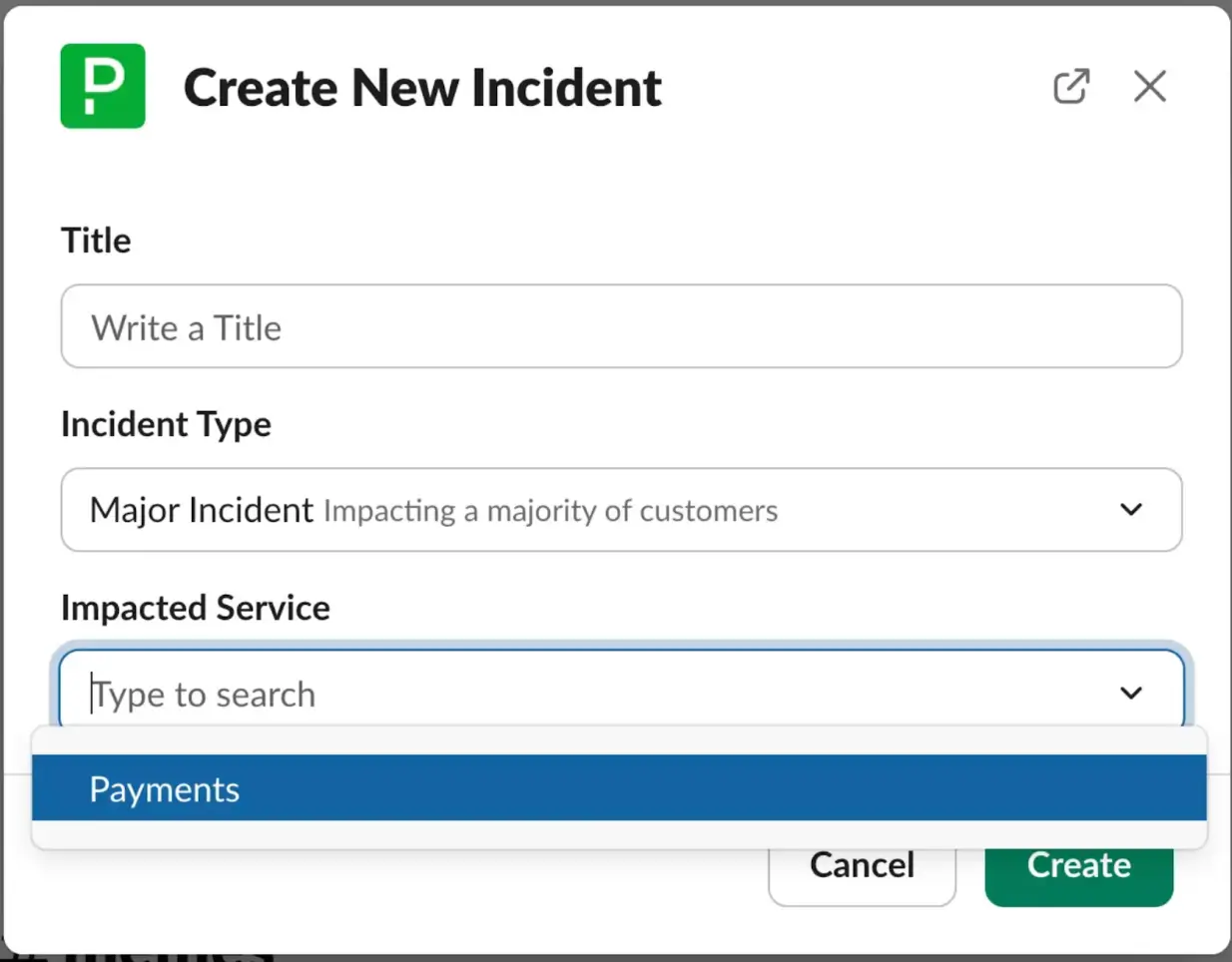
Create New Incident form for unlinked users
If this option is not enabled, unlinked users may still trigger incidents using a Slack workflow, if one has been configured.
Create an Incident Trigger Slack Workflow
Slack workflows can be used to trigger PagerDuty incidents via Slack with pre-configured details such as the associated service. This option is useful for employees who do not have PagerDuty licenses, but still need to be able to trigger PagerDuty incidents in Slack.
Slack Workflows
Slack workflows are developed and maintained by Slack.
With the deprecation of Slack’s legacy workflows, we highly recommend utilizing Slack's new Workflow Builder for creating incident trigger workflows.
The following sample workflow uses the current Workflow Builder’s PagerDuty connector steps. For issues or concerns with these connector steps or a Slack workflow, please reach out to Slack’s Support team.
-
In your Slack desktop app, navigate to Go Workflow Builder.
-
Click New Workflow Build Workflow. Select the option for how you’d like to start the workflow. Enter the required information, if any, then click Continue.
-
Next, you will create a form for users to enter information about the incident. Click Add steps. On the workflow steps modal, search for or select Collect info in a form.
-
On the Collect info in a form modal:
-
Enter the following information:
Field Value Form Title Enter a title for the form, such as Trigger PD incident. -
Click Add Question.
On the Question 1 modal, enter the following information:Field Value Your question Enter Title.
This will be the title of the incident that triggers.Question type Select Short answerMake this required Enable this checkbox. -
Click Done, then click Add Question.
On the Question 2 modal, enter the following information:Field Value Your question Enter Details.
This will populate the custom details of the incident that triggers.Question type Select Short answerMake this required Enable this checkbox. -
Click Done, then click Save on the Collect info in a form modal.
-
-
Next, click Add steps. On the workflow steps modal, search or select the PagerDuty connector’s Trigger an incident step.
-
On the Trigger an incident modal:
-
Select Add just the step, then click Set Up.
-
Click Edit next to the option PagerDuty account being used for this step.
-
On the PagerDuty accounts modal, select whose PagerDuty account should be used for triggering an incident:
- To use a different PagerDuty user account, click Change under Account for workflow building, then select an account from the list of connected accounts, or click Connect to authenticate a new account. After selecting a PagerDuty account, click Done.
- Under Account for workflow use, select the PagerDuty account to use for triggering an incident, then click Save.
-
Click Next.
-
Enter the following information:
Field Value Incident title Click Insert a variable and select Answer to: Titleto add theTitlevalue collected from the form created in step 4.Incident details Click Insert a variable and select Answer to: Detailsto add theDetailsvalue collected from the form created in step 4.Priority (optional) Optionally select the preferred Priority for the new incident. Service Select the preferred Service for the new incident. Escalation policy Select the preferred Escalation Policy for the new incident. -
Click Save.
-
-
If you would like to add an optional message when someone uses this workflow, continue to step 8. If you do not want to add a message, skip to step 9.
-
(Optional) Click Add steps. On the workflow steps modal, search for or select the Send a message to a channel step.
On the Send a message to a channel modal, enter the following information:
Field Value Select a channel Select Channel where the workflow was used.Add a message Enter your preferred message to be sent with the workflow.
Click Insert a variable under the message form to include variables that contain PagerDuty Incident, Escalation Policy, Service, and/or Team data.Click Save.
-
Click Finish Up in the upper right. Enter the workflow’s details and permissions, then click Publish.
Use an Incident Trigger Slack Workflow
- In your Slack desktop app, select a channel with an Incident Trigger Slack Workflow configured click the Run Shortcut icon at the bottom of your text field select the desired workflow (e.g.,
Trigger PD incidentworkflow). - Enter the Title and Details for the incident and click Submit.
This will create an incident in PagerDuty, and you will also be able to see the incident details in your Slack channel.
Add a Slack Contact Method
Once the Slack integration is configured, you can add Slack as an incident contact method. Please read User Profile for more information.
Updated 2 days ago
